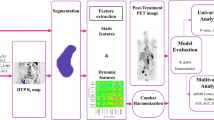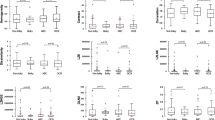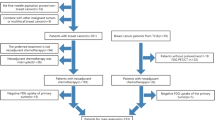Abstract
Purpose
PET-negative residual CT masses (PnRCMs) are usually dismissed as nonviable post-treatment lesions in non-Hodgkin lymphoma (NHL) patients showing complete metabolic response (CMR). We aimed to develop and validate computed tomography (CT)-based radiomics model of PET-negative residual CT mass (PnRCM) for predicting relapse-free survival (RFS) in NHL patients showing CMR.
Methods
A total of 224 patients who showed CMR after completing first-line chemotherapy for PET-avid NHL were recruited for model development. Patients with PnRCM were selected in accordance with the Lugano classification. Three-dimensional segmentation was done by two readers. Radiomic scores (RS) were constructed using features extracted using the Least-absolute shrinkage and selection operator analysis among radiomics features of PnRCMs showing more than substantial interobserver agreement (> 0.6). Cox regression analysis was performed with clinical and radiologic features. The performance of the model was evaluated using area under the curve (AUC). For validation, 153 patients from an outside hospital were recruited and analyzed in the same way.
Results
In the model development cohort, 68 (30.4%) patients had PnRCM. Kaplan–Meier analysis showed that patients with PnRCM had significantly (p = 0.005) shorter RFS than those without PnRCM. In Kaplan–Meier analysis, the high RS group showed significantly (p = 0.038) shorter RFS than the low-scoring group. Multivariate Cox regression analysis showed that high IPI score [hazard ratio (HR) 2.46; p = 0.02], treatment without rituximab (HR 3.821; p = 0.019) were factors associated with shorter RFS. In estimating RFS, combined model in both development and validation cohort showed AUC values of 0.81.
Conclusion
The combined model that incorporated both clinical parameters and CT-based RS showed good performance in predicting relapse in NHL patients with PnRCM.
Graphical abstract






Similar content being viewed by others
Abbreviations
- PnRCM:
-
PET-negative residual CT mass
- AUC:
-
Area under the receiver-operating characteristic curve
- DLBCL:
-
Diffuse large B-cell lymphoma
- ECOG:
-
Eastern cooperative oncology group
- IPI:
-
International prognostic index
- RFS:
-
Relapse-free survival
- LASSO:
-
Least-absolute shrinkage and selection operator
- NHL:
-
Non-Hodgkin lymphoma
- ROC:
-
Receiver-operating characteristic curve
- ROI:
-
Region of interest
References
Matasar MJ, Zelenetz AD (2008) Overview of lymphoma diagnosis and management. Radiol Clin North Am 46:175–198, vii. https://doi.org/10.1016/j.rcl.2008.03.005
Weiler-Sagie M, Bushelev O, Epelbaum R, Dann EJ, Haim N, Avivi I, Ben-Barak A, Ben-Arie Y, Bar-Shalom R, Israel O (2010) 18 F-FDG Avidity in Lymphoma Readdressed: A Study of 766 Patients. J Nucl Med 51:25–30. https://doi.org/10.2967/jnumed.109.067892
Kulkarni NM, Pinho DF, Narayanan S, Kambadakone AR, Abramson JS, Sahani DV (2017) Imaging for Oncologic Response Assessment in Lymphoma. American Journal of Roentgenology 208:18–31. https://doi.org/10.2214/AJR.16.16180
Cheson BD, Fisher RI, Barrington SF, Cavalli F, Schwartz LH, Zucca E, Lister TA (2014) Recommendations for Initial Evaluation, Staging, and Response Assessment of Hodgkin and Non-Hodgkin Lymphoma: The Lugano Classification. JCO 32:3059–3067. https://doi.org/10.1200/JCO.2013.54.8800
Johnson SA, Kumar A, Matasar MJ, Schöder H, Rademaker J (2015) Imaging for Staging and Response Assessment in Lymphoma. Radiology 276:323–338. https://doi.org/10.1148/radiol.2015142088
Dabaja BS, Phan J, Mawlawi O, Medeiros LJ, Etzel C, Liang F-W, Podoloff D, Oki Y, Hagemeister FB, Chuang H, Fayad LE, Westin JR, Shihadeh F, Allen PK, Wogan CF, Rodriguez MA (2013) Clinical implications of positron emission tomography-negative residual computed tomography masses after chemotherapy for diffuse large B-cell lymphoma. Leuk Lymphoma 54:2631–2638. https://doi.org/10.3109/10428194.2013.784967
Scapicchio C, Gabelloni M, Barucci A, Cioni D, Saba L, Neri E (2021) A deep look into radiomics. Radiol med 126:1296–1311. https://doi.org/10.1007/s11547-021-01389-x
Rizzo S, Botta F, Raimondi S, Origgi D, Fanciullo C, Morganti AG, Bellomi M (2018) Radiomics: the facts and the challenges of image analysis. Eur Radiol Exp 2:36. https://doi.org/10.1186/s41747-018-0068-z
Mayerhoefer ME, Materka A, Langs G, Häggström I, Szczypiński P, Gibbs P, Cook G (2020) Introduction to Radiomics. J Nucl Med 61:488–495. https://doi.org/10.2967/jnumed.118.222893
Coskun N, Okudan B, Uncu D, Kitapci MT (2021) Baseline 18F-FDG PET textural features as predictors of response to chemotherapy in diffuse large B-cell lymphoma. Nuclear Medicine Communications 42:1227–1232. https://doi.org/10.1097/MNM.0000000000001447
Parvez A, Tau N, Hussey D, Maganti M, Metser U (2018) 18F-FDG PET/CT metabolic tumor parameters and radiomics features in aggressive non-Hodgkin’s lymphoma as predictors of treatment outcome and survival. Ann Nucl Med 32:410–416. https://doi.org/10.1007/s12149-018-1260-1
Ganeshan B, Miles KA, Babikir S, Shortman R, Afaq A, Ardeshna KM, Groves AM, Kayani I (2017) CT-based texture analysis potentially provides prognostic information complementary to interim fdg-pet for patients with hodgkin’s and aggressive non-hodgkin’s lymphomas. Eur Radiol 27:1012–1020. https://doi.org/10.1007/s00330-016-4470-8
Santiago R, Ortiz Jimenez J, Forghani R, Muthukrishnan N, Del Corpo O, Karthigesu S, Haider MY, Reinhold C, Assouline S (2021) CT-based radiomics model with machine learning for predicting primary treatment failure in diffuse large B-cell Lymphoma. Transl Oncol 14:101188. https://doi.org/10.1016/j.tranon.2021.101188
van Griethuysen JJM, Fedorov A, Parmar C, Hosny A, Aucoin N, Narayan V, Beets-Tan RGH, Fillion-Robin J-C, Pieper S, Aerts HJWL (2017) Computational Radiomics System to Decode the Radiographic Phenotype. Cancer Res 77:e104–e107. https://doi.org/10.1158/0008-5472.CAN-17-0339
Bhatt VR, Vose JM (2014) Hematopoietic stem cell transplantation for non-Hodgkin lymphoma. Hematol Oncol Clin North Am 28:1073–1095. https://doi.org/10.1016/j.hoc.2014.08.015
Hill BT, Rybicki L, Bolwell BJ, Smith S, Dean R, Kalaycio M, Pohlman B, Tench S, Sobecks R, Andresen S, Copelan E, Sweetenham J (2011) The non-relapse mortality rate for patients with diffuse large B-cell lymphoma is greater than relapse mortality 8 years after autologous stem cell transplantation and is significantly higher than mortality rates of population controls. British Journal of Haematology 152:561–569. https://doi.org/10.1111/j.1365-2141.2010.08549.x
(2018) Management of relapsed/refractory DLBCL. Best Practice & Research Clinical Haematology 31:209–216. https://doi.org/10.1016/j.beha.2018.07.014
(2014) Prognostic factors for diffuse large B-cell lymphoma in the R(X)CHOP era. Annals of Oncology 25:2124–2133. https://doi.org/10.1093/annonc/mdu109
Rutherford SC (2019) Surveillance scanning in lymphoma. Clin Adv Hematol Oncol 17:352–359
Mikhaeel NG, Milgrom SA, Terezakis S, Berthelsen AK, Hodgson D, Eich HT, Dieckmann K, Qi S-N, Yahalom J, Specht L (2019) The Optimal Use of Imaging in Radiation Therapy for Lymphoma: Guidelines from the International Lymphoma Radiation Oncology Group (ILROG). Int J Radiat Oncol Biol Phys 104:501–512. https://doi.org/10.1016/j.ijrobp.2019.02.001
Acknowledgements
Kyung-Sook Yang kindly provided statistical advice for this manuscript. We would like to thank the Advanced Medical Imaging Institute in the department of radiology, the Korea University Anam Hospital in the Republic of Korea, and researchers for providing software, datasets, and various forms of technical support.
Funding
This research was supported by a grant of the Korea Health Technology R&D Project through the Korea Health Industry Development Institute (KHIDI), funded by the Ministry of Health & Welfare, Republic of Korea [Grant Number HI22C1302].
Author information
Authors and Affiliations
Corresponding author
Ethics declarations
Conflict of interest
The authors have no relevant financial or non-financial interests to disclose.
Additional information
Publisher's Note
Springer Nature remains neutral with regard to jurisdictional claims in published maps and institutional affiliations.
Rights and permissions
Springer Nature or its licensor (e.g. a society or other partner) holds exclusive rights to this article under a publishing agreement with the author(s) or other rightsholder(s); author self-archiving of the accepted manuscript version of this article is solely governed by the terms of such publishing agreement and applicable law.
About this article
Cite this article
Cha, S.H., Kang, KW., Han, N.Y. et al. Development and validation of CT‑based radiomics model of PET-negative residual CT masses: a potential biomarker for predicting relapse‑free survival in non-Hodgkin lymphoma patients showing complete metabolic response. Abdom Radiol 49, 341–353 (2024). https://doi.org/10.1007/s00261-023-04083-w
Received:
Revised:
Accepted:
Published:
Issue Date:
DOI: https://doi.org/10.1007/s00261-023-04083-w




